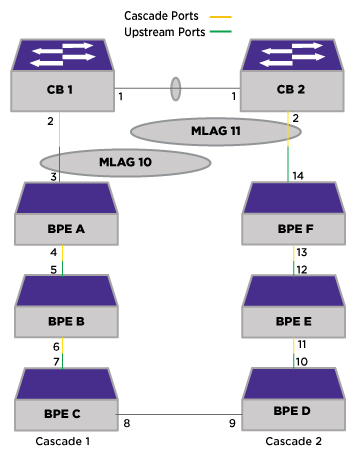
CB-1 and CB-2 are both aware of both MLAGs.
On CB-1, Cascade 1 is configured with port 2 as the native cascade port, and similarly, on CB-2, Cascade 2 is configured with port 2 as the native cascade port.
On CB-1, Cascade 2 is configured to use MLAG 11. On CB-2, Cascade 1 is configured to use MLAG 10. Such configurations are retained by the local CB even if the specified MLAG does not exist when the configuration is first processed.
When the first MLAG comes up, CB-1 and CB-2 elect a master that is the controller of all CSP sessions with BPEs that reside at any tier other than tier 1 (the BPEs directly connected to the CB). The same mastership applies to both MLAGs. Because the MLAGs are one-armed, the master sends messages to such BPEs through the CB that is directly connected to tier 1 of the related cascade. You can determine which CB is the master using the show vpex ports {ports_list} command.
Each CB establishes and controls the CSP session with the tier 1 BPE that is locally connected. The master CB establishes and controls all CSP sessions with BPE that are not at tier 1.

 Print
this page
Print
this page Email this topic
Email this topic Feedback
Feedback